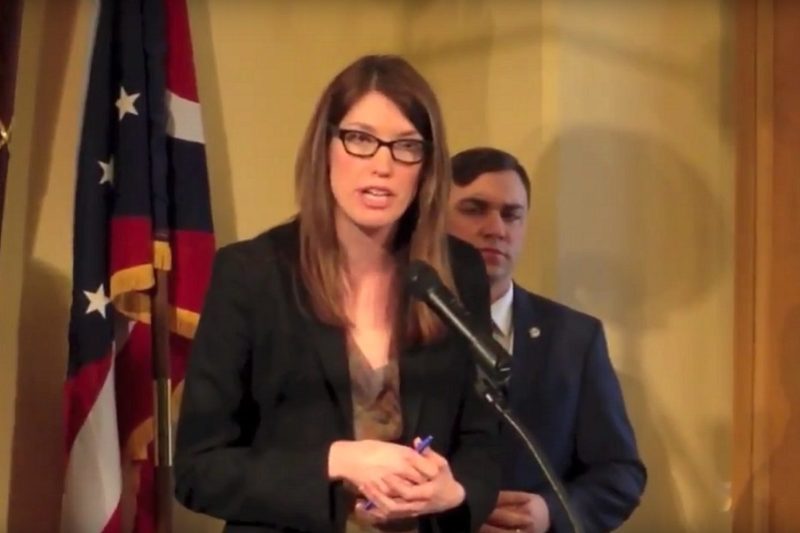Ohio Legislator: ‘Aggressive Attacks’ May Block Voters From the Polls
Efforts to remove voters from state rolls and curb access to the polls could have an outsized impact in Ohio, which has seen a surge of anti-choice legislation under the state’s Republican leadership.

Ohio Rep. Kathleen Clyde (D-Kent) said she is worried about the impact of what she called “aggressive attacks” on voting rights in her state.
Ohio voters who have not engaged in voter activity in a fixed period of time, generally two years, are considered by the state to have moved, which then begins the process of removing them from their rolls through something called the “Supplemental Process.” If a voter fails to respond to a postcard mailed to them to confirm their address, they become “inactive voters.” If an inactive voter does not engage in voter activity for four years, they’re automatically unregistered to vote and must re-register to cast a ballot.
Though other states routinely clean voting rolls, most don’t use failure to vote as a reason to remove someone.
“We have two million voters purged from the rolls in the last five years, many in the last four years since the last presidential election,” Clyde said during an interview with Rewire.
Ohio Secretary of State Jon Husted (R) dismissed concerns of the voter purges’ impact during an interview with Reuters. “If this is really important thing to you in your life, voting, you probably would have done so within a six-year period,” he said.
Ohio’s removal of voters through this process “is particularly problematic in the lead-up to the November 2016 federal election because voters who voted in the high-turnout 2008 federal election (but who did not vote in any subsequent elections) were removed from voter rolls in 2015,” according to an amicus curiae brief filed by the U.S. Department of Justice’s (DOJ) Civil Rights division in support of those who filed suit against Ohio’s law.
The DOJ has urged the 6th U.S. Circuit Court of Appeals to reverse a lower court’s ruling in favor of the state, writing that Ohio’s voter purge violates the National Voter Registration Act of 1993 and the Help America Vote Act of 2002.
Since 2012, at least 144,000 voters have been removed from Ohio’s voter rolls in its three biggest counties, Reuters reported. The secretary of state’s office said 2 million registered voters had been taken off the rolls in the past five years, though many had been removed because they were deceased.
Husted contends that he is just enforcing the law. “Ohio manages its voter rolls in direct compliance of both federal and state laws, and is consistent with an agreement in this same federal court just four years ago,” Husted said in an April statement after the ACLU of Ohio and Demos, a voting rights organization, filed a lawsuit in the matter.
In predominantly Black neighborhoods near downtown Cincinnati, “more than 10 percent of registered voters have been removed due to inactivity since 2012,” reported Reuters. The outlet found that several places where more voters had cast ballots for President Obama in 2012 were the same locations experiencing higher percentages of purged voters.
“Some of the data is showing that African Americans voters and Democratic voters were much more likely affected,” Clyde said when discussing the state’s purge of registered voters.
Clyde has requested data on those purged from the rolls, but has been turned down twice. “They’ve said no in two different ways and are referring me to the boards of elections, but there are 88 boards of election,” she told Rewire. With limited staff resources to devote to data collection, Clyde is still searching for a way to get answers.
In the meantime, many otherwise eligible voters may have their votes thrown away and never know it.
“[P]eople that had been purged often don’t know that they’ve been purged, so they may show up to vote and find their name isn’t on the roll,” Clyde said. “Then, typically that voter is given a provisional ballot and … told that the board of elections will figure out the problem with their voter registration. And then they don’t really receive notice that that provisional ballot doesn’t eventually count.”
Though the state’s voter purges could continue to disenfranchise voters across the state, it is hardly the only effort that may impact voting rights there.
“There have been a number of efforts undertaken by the GOP in Ohio to make voting more difficult,” Clyde said. “That includes fighting to shorten the number of early voting days available, that includes fighting to throw out people’s votes that have been cast—whether it be a provisional ballot or absentee ballot—and that includes purging more voters than any other state.”
This could make a big difference for voters in the state, which has seen a surge of anti-choice legislation under the state’s Republican leadership—including failed Republican presidential candidate Gov. John Kasich.
“So aside from the terrible effect that has on the fundamental right to vote in Ohio, progressives who maybe are infrequent voters or are seeing what’s happening around [reproductive rights and health] issues and want to express that through their vote may experience problems in Ohio because of these aggressive attacks on voting rights,” Clyde said.
“From our presidential candidates on down to our candidates for the state legislature, there is a lot at stake when it comes to reproductive health care and reproductive rights in this election,” Clyde added. “So I think that, if that is an issue that is important to any Ohioan, they need to have their voice heard in this election.”
